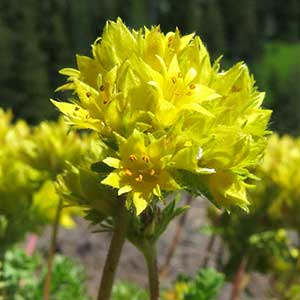Ivesia gordonii
Ivesia campestris
alpine ivesia, alpine mousetail, Gordon's ivesia
field ivesia, field mousetail, Kaweah ivesia
prostrate to erect, (0.2–)0.5–4 dm.
decumbent to ascending, 1–3.5 dm.
tightly to loosely cylindric, (1–)3–20(–25) cm; sheathing base ± glandular abaxially, otherwise glabrous;
petiole 0.5–8 cm, hairs 0.2–0.5 mm;
leaflets (6–)10–25 per side, (1–)2–13(–18) mm, glabrous or ± hirsute or villous, glandular-puberulent or -pubescent, lobes (2–)4–8(–15), linear or narrowly oblanceolate to obovate, apex rarely setose.
(3–)5–15(–18) cm; sheathing base glabrous or sparsely strigose abaxially;
stipules ± lanceolate, 2.5–5 mm;
petiole (0.3–)0.5–6(–8) cm, hairs sparse to abundant, appressed-ascending, 1–2 mm;
leaflets 15–20 per side, loosely overlapping, 2–10 mm, lobes 2–5, oblanceolate, hairs sparse to abundant, spreading to ascending, 1–2 mm.
1(–2), not paired.
3–4.
5–50(–70)-flowered, 1–8(–11) cm diam.;
glomerules 1–several.
5–20(–40)-flowered, (1–)1.5–2.5(–4) cm diam., flowers arranged in 1–few ± tight glomerules of 10–15 flowers.
1–3(–5) mm.
1–4 mm.
5–12 mm diam.;
epicalyx bractlets linear to narrowly elliptic, (0.5–)1–3.5(–4) mm;
hypanthium turbinate to campanulate, (1.5–)2–4(–4.5) × 2–4(–5) mm;
sepals (2–)2.5–5(–6) mm, obtuse to ± acute;
petals yellow, narrowly oblanceolate to narrowly spatulate, (1–)1.5–3 mm;
stamens 5, filaments 1.3–2.5 mm, anthers yellow, sometimes red-margined, 0.5–1 mm;
carpels (1–)2–4(–6), styles 2.5–4.5(–6) mm.
7–10 mm diam.;
epicalyx bractlets linear to oblong, 1–2(–2.5) mm;
hypanthium campanulate, 1–2 × 2.5–4 mm, ± 1/2 as deep as wide;
sepals green, 2–3(–3.5) mm, acute;
petals 4(–5), light yellow, oblanceolate to spatulate or narrowly obovate, 3–4 mm;
stamens 12–16 (4-merous flowers) or 16–20 (5-merous flowers), filaments filiform, 0.6–1.1 mm, anthers yellowish, 0.3–0.5 mm;
carpels 4–20, styles 1.4–2 mm.
grayish brown to mottled brown, ± 2 mm.
light brown, 1–1.5 mm.
Ivesia gordonii
Ivesia campestris
Varieties 4 (4 in the flora).
Ivesia gordonii is the most widespread species of the genus, occurring from Washington to Montana, south to central California and Colorado. The species can be distinguished from other members of sect. Ivesia by the relatively deep hypanthium, which is about as deep as wide. Four varieties are provisionally recognized here (B. Ertter and J. L. Reveal 2007), with the likelihood that future work may indicate additional and/or alternate circumscriptions. Populations that are difficult to assign to a variety can be found where the recognizable taxonomic units come together, for example, in northeastern Utah and western Wyoming, involving var. gordonii and var. wasatchensis, and in California and central Idaho where var. alpicola and var. ursinorum tend to merge.
(Discussion copyrighted by Flora of North America; reprinted with permission.)
Ivesia campestris is found in the southern Sierra Nevada south of the Kings River, where it replaces I. unguiculata and often occurs at higher elevations.
Ivesia campestris is the only member of the genus that commonly has 4-merous flowers. It is sometimes misidentified as I. unguiculata, especially when the pale yellow petals have faded to creamy white; the glomerules of the inflorescences tend to be yellowish green to green rather than purplish. Also, the anthers of I. campestris are yellowish, rather than maroon.
(Discussion copyrighted by Flora of North America; reprinted with permission.)
1. Leaflets 7–13(–18) mm, glabrous or sparsely hirsute or villous marginally; stems (1–)1.5–4 dm; inflorescences usually branched, 2–8(–11) cm diam., glomerules (1–)2–6(–10), ± capitate. | var. wasatchensis |
1. Leaflets (1–)2–7(–9) mm, hairy or ± glabrous except marginally ciliate; stems (0.2–)0.5–2.5 dm; inflorescences simple or branched, 1–3(–5) cm diam., glomerules 1(–3), ± capitate to loosely congested | → 2 |
2. Stems usually prostrate to ascending, rarely nearly erect, usually dark reddish, minutely glandular or glandular-puberulent to -pubescent; leaves to 0.8 cm diam.; anthers usually red-margined. | var. ursinorum |
2. Stems usually ascending to erect, sometimes decumbent, usually greenish, rarely reddish, hirsute to villous, glandular-puberulent to -pubescent; leaves to 1.5 cm diam.; anthers rarely red-margined | → 3 |
3. Stems usually hirsute to villous, sometimes densely so, glandular-pubescent or eglandular; basal leaves (3–)5–10(–15) cm; flowers 7–12 mm diam.; e Idaho and w Montana to Utah, Wyoming, and w Colorado. | var. gordonii |
3. Stems not or sparsely hirsute to villous, glandular-puberulent or -pubescent; basal leaves 2–8(–10) cm; flowers 5–9 mm diam.; s Washington to California and e to w Montana. | var. alpicola |


